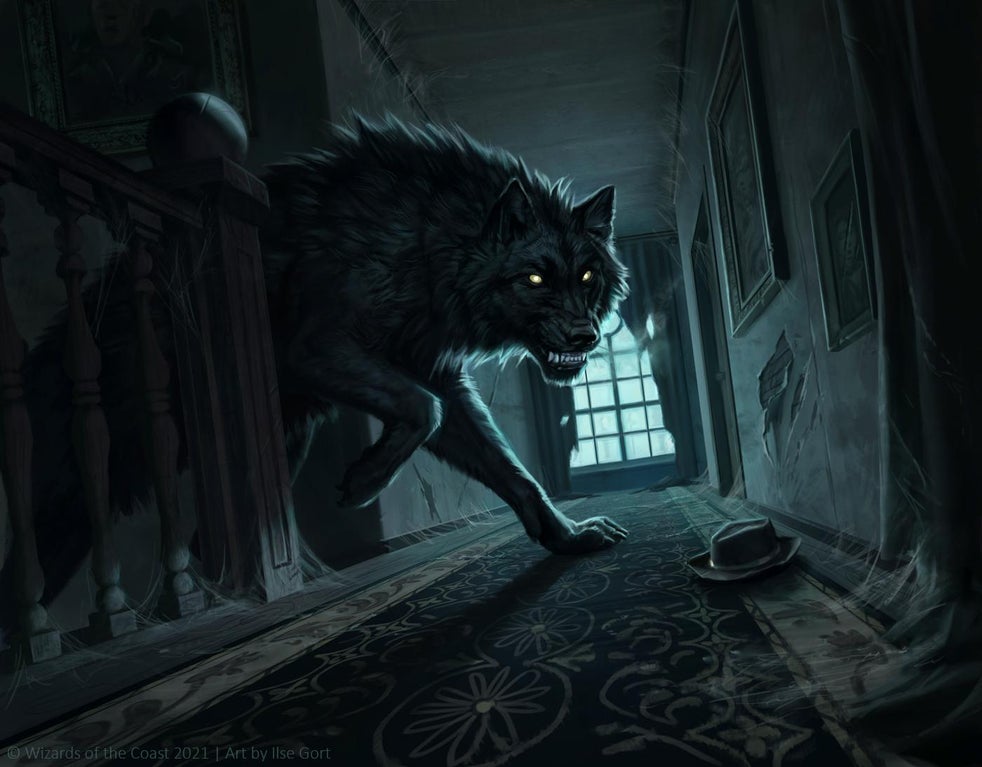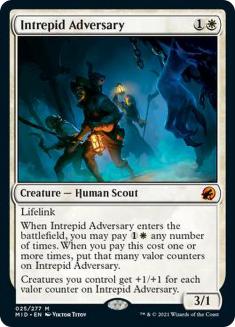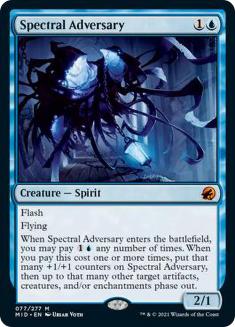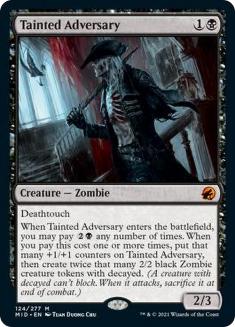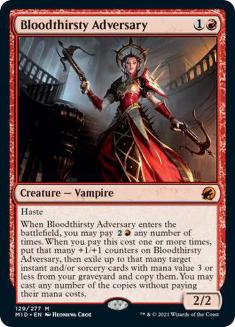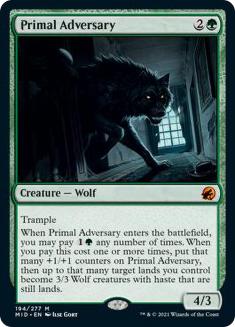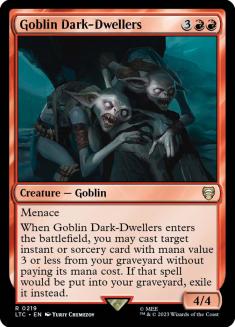If you’ve followed some of my work, you’ve probably noticed that I’m a big fan of flexibility. I absolutely love cards that can be strong early and that scale well later into the game, as well as cards with many different mods (which is part of why I was so drawn to Adventures creatures such as Bonecrusher Giant and Brazen Borrower very early on). As such, the new cycle of Adversaries is right in my wheelhouse.
This new cycle is very appealing to me because it adds flexibility at a time when it’s the most relevant – making it so that a card can be good both in the early-game and in the mid-to late-game. Not all flexibility is equal; for example, if they were to add kicker to Ugin, the Spirit Dragon, this would make the card better but it wouldn’t change how it functions inside of a game, and even something like Goldspan Dragon would not be radically different from what it is now if it had a kicker ability.
In the case of the Adversaries, though, they’re cheap enough that their ability allows them to function as totally different cards over the course of the game — they can be the first card you cast in a game or the last one. For two mana you get a solid early drop, for four/five mana you get a reasonable midrange card, and for eight you get a game-winning effect. To me, this flexibility is worth a lot.
The most important aspect of the Adversaries is that, on their own, they all have a reasonable baseline. A 3/1 lifelinker for two mana isn’t good, but it’s not a disaster if you have to cast it; the same is true for all the other ones. A lot of the time, you’ll just cast these cards as two-drops and you will be very happy about having something that fills your curve, because having a two-drop to cast is often the difference between winning or losing a game.
Their ability is very similar to something we’ve had before — multikicker — with a couple of key differences:
- The costs are only paid on resolution. If they counter your spell, you don’t have to commit your mana. Your card is an eight-drop if it resolves but only a two-drop if it doesn’t, which means you only use a small amount of your resources if this ends up countered, rather than wasting your whole turn. If you have a lot of mana and two of these cards in your hand, you can effectively present two eight-drops in the same turn. This is especially important versus “counter unless you pay X” effects, such as Mana Leak or Jwari Disruption; they can stop you from paying the “multikicker” as many times as you wanted but they will not counter your whole spell.
- You can pay the cost even if an Adversary enters the battlefield through non-conventional means. With multikicker, you had to be casting the card from your hand; with the Adversaries, it’s going to work as long as the card gets to the battlefield. You can, for example, cheat them in via Aether Vial, which should leave all your mana to pay for their effect. You can also blink them or reanimate them with something like Lurrus of the Dream-Den or even hit them with Collected Company.
- This offers your opponent a window to respond that would not exist with most instances of multikicker. For example, if you cast Bloodthirsty Adversary with five mana, then your opponent can Shock it before you put your counter on (though you still get to trigger the second part of the ability).
Now, let’s rank them!
5. Spectral Adversary
While I ranked Spectral Adversary last, this is not because I believe it’s horrible. I actually think this card is quite strong. I just like the others in the cycle a little bit more.
The best part about this card is the baseline — a 2/1 flash flyer for two mana. We’ve seen it before in some other Spirits, but it’s a pretty aggressive statline for something that’s the bare minimum of what the card does. Then, for an extra two mana, you get a 3/2 flyer instead and you get to phase something out. Phasing something out essentially means removing it as an attacker, removing it as a blocker, or saving it from a removal spell (even a sweeper).
The best part about this card, in my opinion, is that if you spend four or six mana, it becomes quite the damage swing out of nowhere; you can cast it at the end of the turn, remove one or two blockers, and attack for three or four. It can also potentially stop two attackers while blocking another. It reminds me of a Faeries card in how flexible it is and I love that.
Additionally, Spectral Adversary is a Spirit, which means it can slot into Spirits-themed decks. In Standard, however, I don’t think the support is quite there yet (perhaps Historic can make a Spirits deck work just like Pioneer did). The best place for this card in Standard seems to be a Mono-Blue Aggro-style deck, where you can pair it with the newly reprinted Delver of Secrets.
Creatures (14)
Lands (25)
Spells (21)

4. Tainted Adversary
Tainted Adversary’s baseline body is, in my opinion, better than it looks. A 2/3 is a surprisingly good blocker early on and can cause problems to a number of aggressive decks. The fact that it has deathtouch means it can trade with much bigger creatures either on offense or defense.
The ability, however, is a bit lackluster, and looks better than it actually is. It’s easy to look at this and say “seven power for five mana,” but over half of that is going to disappear after the first attack and then you’ll be left with a 3/4. If you’re paying five, this card is a worse Diregraf Horde, and that’s a common.
The reason I have this card as #4 instead of #5, aside from the fact that I think the baseline body is good, is that it looks like we’re going to have a Zombies deck in Standard, at which point you’re getting a little bit more out of the ability. Imagine, for example, that you have Champion of the Perished on the battlefield. All of a sudden, by paying five mana with Tainted Adversary, you’re giving it +3/+3 forever. If you have Bladestitched Skaab, you’re suddenly getting an extra power on all your tokens and threatening to do a lot of damage.
I’m not sure if we’re going to have more Zombies-themed cards in Innistrad: Midnight Hunt (hopefully yes), but here’s what such a deck might look like for now:
Creatures (21)
- 4 Shambling Ghast
- 4 Champion of the Perished
- 3 Jadar, Ghoulcaller of Nephalia
- 2 Poppet Stitcher
- 4 Bladestitched Skaab
- 4 Tainted Adversary
Lands (23)
Spells (16)

3. Intrepid Adversary
Intrepid Adversary is different from the other Adversaries because all of the value is contained inside that one creature — if they kill it, then it doesn’t matter how much you spent because it’s not going to have any effect. If they kill Bloodthirsty Adversary, for example, you still get to cast some spells from your graveyard; if they kill Tainted Adversary, you still get your Zombie tokens; and so on.
The 3/1 lifelink for 1W baseline can range from bad to good depending on what you’re playing against, as lifelink is a pretty binary keyword — it can be great if you’re racing or totally useless if you’re playing versus a control deck that doesn’t care about your life total (as opposed to something like haste or flash, which will be good no matter what). Overall it’s on the weak side as far as abilities go, which is unfortunate because in a white aggro deck you’re always casting this on two if you have no other plays, but the floor is potentially high.
If you cast this for 2WW, you get a 4/2 Benalish Marshal. Having two toughness can be a lot worse than having three, but it looks like most of the damage-based removal in this format deals three damage (Frost Bite, Dragon’s Fire, etc.), so the difference is not that stark — if Bonecrusher Giant was still around, then it would be much more meaningful. Then, if you have extra mana, this can provide a ton of damage out of nowhere while also being a solid body in itself.
So, where would I play this? The first thing I would try is Mono-White Aggro:
Creatures (29)
- 2 Skyclave Apparition
- 4 Luminarch Aspirant
- 4 Usher of the Fallen
- 4 Elite Spellbinder
- 3 Brutal Cathar
- 4 Chaplain of Alms
- 4 Intrepid Adversary
- 4 Sungold Sentinel
Lands (24)
Spells (7)

2. Primal Adversary
Primal Adversary’s baseline body is not bad — you were happy to cast Bonecrusher Giant for three mana a lot of the time and it’s similar to that — but there’s just something about all the other Adversaries being a two-drop that’s not replicated in a three-drop. Two-drops are hard to find and they can be very valuable; having a two-drop or not having a two-drop can dictate the pace of the game entirely. Three-drops are abundant, more powerful, and more easily replaced. If you have two two-drops, that “makes” a three-drop (meaning you have something to cast on Turn 3). If you have two three-drops, that does not make a two-drop, and there’s a chance the game will end without you having cast your second one. As such, the bar on three-drops is much higher. In the end, however, I think a 4/3 trampler for three mana clears it.
The ability on Primal Adversary is, well, weird, because the lands don’t untap, so you often have to choose between turning an extra land or attacking with the one you already have. In a way, this card has even more modes than the others — for five mana you get a 5/4 and a 3/3, but for six mana you get a 6/5 and a 3/3 with haste. Then, for seven mana, you can get either two tapped 3/3s or an untapped 3/3. This means that each mana that you have access to effectively changes the mode on this card, rather than each two or three mana.
There are certainly better five and six-drops that you can play, but, much like with the other members of this cycle, I believe the flexibility is worth a lot. How much is it worth that your five- or six-drop can be cast on Turn 3 in a pinch? Quite a bit.
I think that on power level alone this is not worthy of second place on the list, but the context of the set around it might make it so. First, we already know there’s a Mono-Green Aggro deck that’s going to be relatively strong — it’s a strong deck in Standard 2022 after all, and this card would slot right in (besides, it has just enough power to crew Esika’s Chariot, which is one of the best cards in the format). Second, it’s a Wolf that makes more Wolves and this is the Wolf set with Wolf synergies. I think it’s very likely that this card sees play.
As mentioned earlier, Mono-Green Aggro is a great place to start:
Creatures (20)
Planeswalkers (1)
Lands (25)
Spells (14)

1. Bloodthirsty Adversary
I think Bloodthirsty Adversary is one of the best cards in Innistrad: Midnight Hunt and it’s very likely to see play. At a baseline of 2/2 haste for 1R, we know that Bloodthirsty Adversary is already decent enough to be part of an aggro deck, as that was basically what Robber of the Rich was. Obviously Robber of the Rich had other abilities (including sneakily having reach), but most of what you were getting was the 2/2 haste for 1R, replicated here. You might not play a 2/2 haste for 1R with no other abilities, but if it’s that what you end up doing with Bloodthirsty Adversary it’s in no way an embarrassment, and it might be just what you need to fill up your curve (similarly to how casting a Turn 3 Bonecrusher Giant was maybe not the best, but still good a lot of the time).
Then, once we get to the “multikicker” part of it, the card becomes very strong and arguably a better version of Goblin Dark-Dwellers.
Now, Goblin Dark-Dwellers isn’t a home run or anything, but it has seen competitive play. As a five-drop, this card is a 3/3 haste instead of a 4/4 menace, which makes it worse if you’re casting specifically a three-damage sweeper (such as Anger of the Gods), but likely better if you’re attacking — I’d rather deal three damage for sure now than deal potentially four later on. If you can use the ability on a burn spell, this will have the chance to hit for six or seven damage out of nowhere.
Then, we get the ability to do this more than once. Eight mana is a lot, but it also happens, and when it does you’ll be glad you have access to Bloodthirsty Adversary and not Goblin Dark-Dwellers. A 4/4 haste with two spells attached will be similar to casting Magma Opus and should win the game most of the time.
The biggest challenge with Bloodthirsty Adversary is that, the more mileage you have out of the “play a spell for free” clause, the less interested you are likely to be in a 2/2 haste creature. Red aggro decks will be super into the 2/2, but won’t have many stupendous spells to cast (you’re usually just going to get something like three damage). Decks with things like Prismari Command, Seize the Spoils, or Check for Traps will love the five- and eight-mana versions, but will be less interested in the 2/2 with haste.
Right now, Standard is the smallest it gets, so I think the straightforward approach is best and I would try slotting this in a Mono-Red Aggro build, where I expect it to be a staple for all of its tenure in Standard. Keep in mind though that this card will only get better as the format grows larger, and it’s also a Vampire, so it has a decent chance of getting cool synergies in the very next set, so we’ll almost certainly see it in different archetypes by some time next year.
Creatures (25)
- 2 Goldspan Dragon
- 4 Hall Monitor
- 4 Flameskull
- 3 Goblin Javelineer
- 4 Flame Channeler
- 4 Bloodthirsty Adversary
- 4 Falkenrath Pit Fighter
Lands (24)
Spells (11)

All in all, I’m very excited for the Adversary cycle. There’s so much flexibility and no small amount of power, so it would shock me if some of them at least didn’t end up being very good Standard cards. I look forward to seeing what people come up with to incorporate them into existing decks or entirely new builds.

